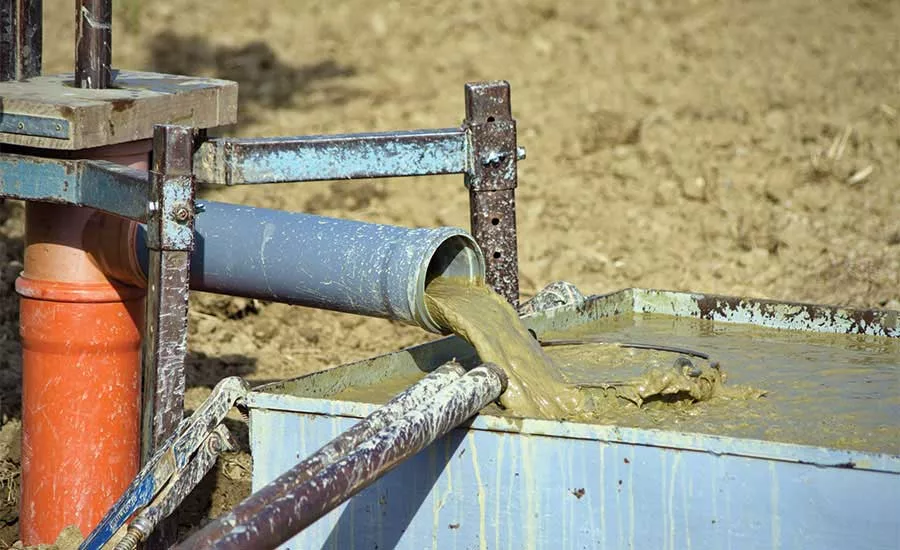Questions, Answers About Hole Stabilization on Drilling Jobs

One of the most important functions of a drilling fluid is to stabilize and maintain a borehole opening. Borehole stability in coarse soils starts with creating an impermeable barrier between the soil and the drilling fluid or slurry via the filter cake (or polymer gel membrane for non-rotary mud drilling such as foundation drilling). Then, positive hydrostatic pressure from having the hole full of fluid to a level above the water table exerts itself against the impermeable barrier to keep the formation stable.
If either of these two components (impermeable barrier or filter cake, and positive hydrostatic head pressure) is missing or not functioning correctly (as in cases of high fluid loss), borehole stability is compromised and the hole will fall in when drilling through coarse soils. Drilling fluid professionals spend a large portion of their time troubleshooting drilling projects and answering questions from drilling contractors, and here are some frequently asked questions regarding borehole stability.
Q. The bentonite drilling fluid is separating and a lens of water is forming on top of the bentonite. What can I do to resolve this?
A. The fact that the bentonite drilling fluid is separating is a direct indicator of poor filtration control/high fluid loss, and should be a red flag indicating that something needs to be done or the hole will not be stable. Calcium/hard water can flocculate the bentonite platelets (that is, clump them together) and cause them to settle. This leads to extremely high fluid loss. Add soda ash at one-quarter to one-half a pound per 100 gallons of freshwater to increase pH and soften the water. If chlorine is present in the water, utilize a dechlorinating agent such as De-Chlor or circulate the water to evaporate out the chlorine. Polymers, additives, drilling detergents and even drill foam will perform dramatically better by pre-treating the mix water with soda ash to a pH of between 8.5 and 9.5 (do not overdose).
Q. How can I thin my drilling fluid so that the solids can settle out?
A. Thinners can be added in small increments to lower viscosity and gel strength, while actually enhancing fluid-loss/filtration control.
Q. What should I use for loss-circulation problems that will not plug the well screens and reduce water well performance?
A. Acid soluble loss-circulation products can be used to help control loss-circulation during the drilling process, and then be dissolved from around the well screen and gravel pack during well development to prevent well pump screen plugging. Also, monitor mud weight and sand content, because high density drilling fluids put excessive pressure on formations and can cause loss-circulation problems.
Q. How do I keep the sides of the borehole from sluffing off in sandy conditions?
A. Good filtration control is paramount to creating an impermeable filter cake needed for borehole stability, and that starts with pretreating the mix water with soda ash and using the correct amount of bentonite, along with a PAC (poly anionic cellulose) polymer.
Q. Why does it seem like there is more sand and my filter screens clog when I use one particular brand of bentonite over another?
A. Bentonite drilling fluid products from all Wyoming-bentonite brands have similar amounts of sand content. During the process of making bentonite drilling fluid products, they are all tested frequently and screened through 200-mesh screens to eliminate sand. Each lot has a specification to meet and is not shipped out until specification is complete. Most often, the range is from a trace to one quarter of one percent, which is well under the spec. All of the major Wyoming-bentonite companies ensure that their products meet the criteria defined in American Petroleum Institute (API) Specification 13A.
Q. Is there one magical drilling fluid for all conditions?
A. No. There are no universal soils; therefore, there are no universal drilling fluids. However, using one-half a pound of soda ash per 100 gallons of freshwater, 15 to 25 pounds of high-yield bentonite per 100 gallons of freshwater, and one-half to one-and-a-half pounds of dry PAC polymer per 100 gallons of freshwater is the closest there is. This mix will take care of about 85 to 90 percent of problems.
Q. What is the difference between PAC polymer and low-viscosity PAC polymers (such as Rel-Pac and Rel-Pac Xtra-Low)?
A. “PAC” stands for poly anionic cellulose. It is a negatively charged mixture of polymer and cellulose (plant fiber). The Xtra-Low means that the polymer is low viscosity, so it will not increase the viscosity of the drilling fluid. The product should provide the same fluid-loss benefits. PAC polymer can help facilitate borehole stability by dramatically enhancing fluid-loss control, but also help inhibit reactive clays and will not blind shaker screens on drilling fluids recycling systems.
There is really no big mystery behind drilling a stable hole through coarse soil conditions. As previously mentioned, there are two key components to borehole stability. The first is having an impermeable barrier between the drilling fluid and the formation (filter cake or polymer gel membrane for foundation drilled shafts). The second is the use of hydrostatic head pressure to apply even positive pressure against the filter cake to stabilize the formation. If the filter cake does not provide a good seal (high fluid loss), the hydrostatic pressure is no longer applied to the surface of the filter cake and the formation falls in. Good fluid loss control starts with using fresh water and pre-treating the water with soda ash to neutralize the calcium so that the bentonite, polymers and additives can work correctly. Check with the manufacturers of drilling fluid products to find user guides and dosage charts to help determine the correct products and dosages for whatever soil conditions may be encountered.
Looking for a reprint of this article?
From high-res PDFs to custom plaques, order your copy today!

